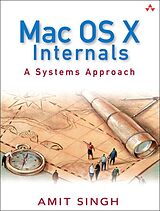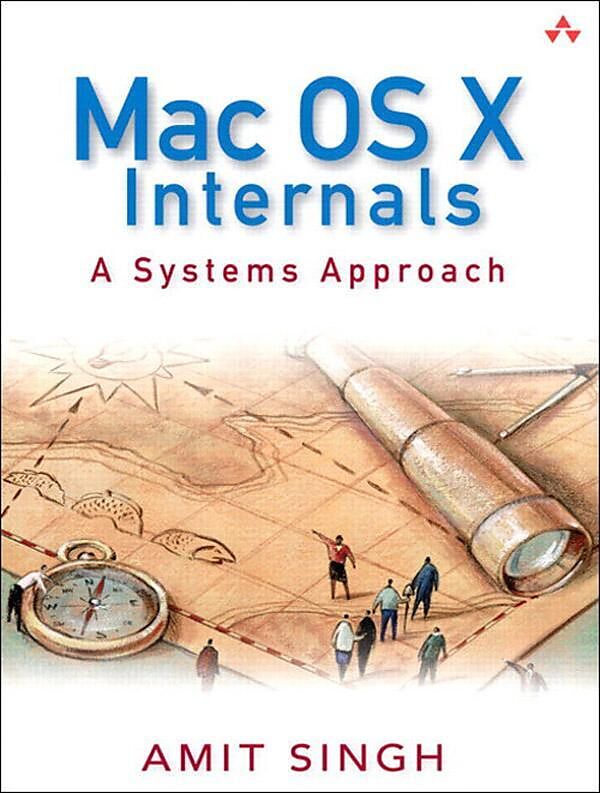Mac OS X Internals
Format:
E-Book (EPUB)
EAN:
9780132702263
Untertitel:
A Systems Approach
Genre:
Betriebssysteme, Benutzeroberflächen
Autor:
Amit Singh
Herausgeber:
Pearson ITP
Erscheinungsdatum:
19.06.2006
Mac OS X was released in March 2001, but many components, such as Mach and BSD, are considerably older. Understanding the design, implementation, and workings of Mac OS X requires examination of several technologies that differ in their age, origins, philosophies, and roles. Mac OS X Internals: A Systems Approach is the first book that dissects the internals of the system, presenting a detailed picture that grows incrementally as you read. For example, you will learn the roles of the firmware, the bootloader, the Mach and BSD kernel components (including the process, virtual memory, IPC, and file system layers), the object-oriented I/O Kit driver framework, user libraries, and other core pieces of software. You will learn how these pieces connect and work internally, where they originated, and how they evolved. The book also covers several key areas of the Intel-based Macintosh computers. A solid understanding of system internals is immensely useful in design, development, and debugging for programmers of various skill levels. System programmers can use the book as a reference and to construct a better picture of how the core system works. Application programmers can gain a deeper understanding of how their applications interact with the system. System administrators and power users can use the book to harness the power of the rich environment offered by Mac OS X. Finally, members of the Windows, Linux, BSD, and other Unix communities will find the book valuable in comparing and contrasting Mac OS X with their respective systems. Mac OS X Internals focuses on the technical aspects of OS X and is so full of extremely useful information and programming examples that it will definitely become a mandatory tool for every Mac OS X programmer.
Autorentext
Amit Singh is an operating systems researcher, programmer, and author. He manages the Macintosh engineering team at Google. Previously, Amit has worked on operating systems at IBM Research, Bell Laboratories, and a Silicon Valley startup doing cutting-edge work in the area of virtualization. He also created and maintains and . Amit often writes and releases open source software, such as MacFUSE, a Mac OS X implementation of the FUSE (File System in USEr Space) mechanism.
Inhalt
Preface xxv Acknowledgments xxxi About the Author xxxiii Chapter 1 Origins of Mac OS X 1 1.1 Apple's Quest for the Operating System 2 1.2 The NeXT Chapter 9 1.3 The Mach Factor 15 1.4 Strategies 24 1.5 Toward Mac OS X 31 Chapter 2 An Overview of Mac OS X 43 2.1 Firmware 46 2.2 Bootloader 46 2.3 Darwin 46 2.4 The xnu Kernel 48 2.5 A User-Space View of the File System 57 2.6 The Runtime Architecture 61 2.7 The C Library 74 2.8 Bundles and Frameworks 76 2.9 Core Services 89 2.10 Application Services 90 2.11 Application Environments 101 2.12 User Interface 117 2.13 Programming 121 2.14 Security 131 2.15 Mac OS X Server 145 2.16 Networking 153 Chapter 3 Inside an Apple 155 3.1 The Power Mac G5 156 3.2 The G5: Lineage and Roadmap 166 3.3 The PowerPC 970FX 174 3.4 Software Conventions 224 3.5 Examples 240 Chapter 4 The Firmware and the Bootloader 263 4.1 Introduction 263 4.2 A Whole New World 266 4.3 Power-On Reset 271 4.4 Open Firmware 272 4.5 Forth 279 4.6 The Device Tree 289 4.7 Open Firmware Interfaces 298 4.8 Programming Examples 300 4.9 Firmware Boot Sequence 324 4.10 BootX 328 4.11 Alternate Booting Scenarios 340 4.12 Firmware Security 349 4.13 Launching the Kernel 352 4.14 The BootCache Optimization 353 4.15 The Boot-Time Kernel Arguments 355 4.16 The Extensible Firmware Interface 362 Chapter 5 Kernel and User-Level Startup 381 5.1 Arranging for the Kernel to Execute 382 5.2 Low-Level Processor Initialization 388 5.3 High-Level Processor Initialization 405 5.4 Mach Subsystem Initialization 421 5.5 The First Thread 432 5.6 I/O Kit Initialization 435 5.7 BSD Initialization 443 5.8 Launching the First User-Space Program 469 5.9 Slave Processors 470 5.10 User-Level Startup 472 Chapter 6 The xnu Kernel 501 6.1 xnu Source 501 6.2 Mach 510 6.3 A Flavor of the Mach APIs 519 6.4 Entering the Kernel 529 6.5 Exception Processing 543 6.6 System Call Processing 553 6.7 System Call Categories 557 6.8 Kernel Support for Debugging, Diagnostics, and Tracing 601 6.9 Virtual Machine Monitor 659 6.10 Compiling the Kernel 676 Chapter 7 Processes 683 7.1 Processes: From Early UNIC to Mac OS X 684 7.2 Mach Abstractions, Data Structures, and APIs 687 7.3 Many Threads of a New System 726 7.4 Scheduling 774 7.5 The execve() System Call 812 7.6 Launching Applications 828 Chapter 8 Memory 835 8.1 Looking Back 835 8.2 An Overview of Mac OS X Memory Management 838 8.3 Mac VM 846 8.4 Resident Memory 868 8.5 Virtual Memory Initialization during Bootstrap 877 8.6 The Mach VM User-Space Interface 878 8.7 Using the Mach VM Interfaces 893 8.8 Kernel and User Address Space Layouts 907 8.9 Universal Page Lists (UPLs) 912 8.10 Unified Buffer Cache (UBC) 913 8.11 The Dynamic Pager Program 918 8.12 The Update Daemon 921 8.13 System Shared Memory 922 8.14 Task Working Set Detection and Maintenance 942 8.15 Memory Allocation in User Space 948 8.16 Memory Allocation in the Kernel 980 8.17 Memory-Mapped Files 1001 8.18 64-bit Computing 1005 Chapter 9 Interprocess Communication 1021 9.1 Introduction 1021 9.2 Mach IPC: An Overview 1025 9.3 Mach IPC: The Mac OS X Implementation 1041 9.4 Name and Bootstrap Servers 1060 9.5 Using Mach IPC 1080 9.6 MIG 1094 9.7 Mach Exceptions 1112 9.8 Signals 1129 9.9 Pipes 1145 9.10 Named Pipes (Fifos) 1147 9.11 File Descriptor Passing 1148 9.12 XSI IPC 1155 9.13 POSIX IPC 1156 9.14 Distributed Objects 1164 9.15 Apple Events 1172 9.16 Notifications 1181 9.17 Core Foundation IPC 1197 9.18 Synchronization 1210 Chapter 10 Extending the Kernel 1233 10.1 A Driver down the Memory Lane 1233 10.2 The I/O Kit 1235 10.3 DART 1257 10.4 Dynamically Extending the Kernel 1259 10.5 Communicating with the Kernel 1269 10.6 Creating Kernel Extensions 1271 10.7 A Programming Tour of the I/O Kit's Functionality 1288 10.8 Debugging 1321 Chapter 11 File Systems 1345 11.1 Disks and Partitions 1345 11.2 Disk Arbitration 1353 11.3 The Implementation of Disk Devices 1362 11.4 Disk Images 1366 11.5 Files and File Descriptors 1374 11.6 The VFS Layer 1376 11.7 File System Types 1386 11.8 Spotlight 1409 11.9 Access Control Lists 1441 11.10 The Kauth Authorization Subsystem 1445 Chapter 12 The HFS Plus File System 1471 12.1 Analysis Tools 1474 12.2 Fundamental Concepts 1477 12.3 The Structure of an HFS+ Volume 1491 12.4 Reserved Areas 1493 12.5 The Volume Header 1493 12.6 The HFS Wrapper 1501 12.7 Special Files 1505 12.8 Examining HFS+ Features 1531 12.9 Optimizations 1558 12.10 Miscellaneous Features 1570 12.11 Comparing Mac OS X File Systems 12.12 Comparing HFS+ and NTFS 1582 Appendix A Mac OS X on x86-Based Macintosh Computers 1587 A.1 Hardware Differences 1587 A.2 Fir…

Leider konnten wir für diesen Artikel keine Preise ermitteln ...
billigbuch.ch sucht jetzt für Sie die besten Angebote ...
Die aktuellen Verkaufspreise von 3 Onlineshops werden in Realtime abgefragt.
Sie können das gewünschte Produkt anschliessend direkt beim Anbieter Ihrer Wahl bestellen.
Loading...
Die aktuellen Verkaufspreise von 3 Onlineshops werden in Realtime abgefragt.
Sie können das gewünschte Produkt anschliessend direkt beim Anbieter Ihrer Wahl bestellen.
| # | Onlineshop | Preis CHF | Versand CHF | Total CHF | ||
|---|---|---|---|---|---|---|
| 1 | Seller | 0.00 | 0.00 | 0.00 |
